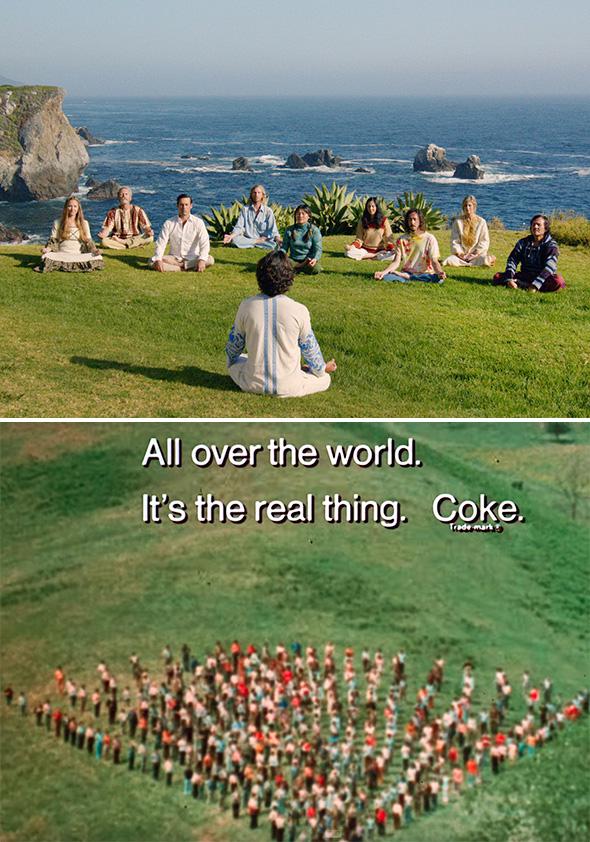It took no time at all for Mad Men fans to start debating the final scene of the series, which finds a newly peaceful Don meditating among a group of hippies in the hills of Big Sur. While the general consensus seems to be that Don was responsible for the iconic 1971 Coca-Cola ad “Hilltop” and its accompanying “I’d Like to Buy the World a Coke” jingle, some fans don’t buy it, or they believe that it was actually Peggy’s brainchild:
But aside from a pretty generic shot of Peggy typing, and Pete’s premonition that “someday people are going to brag that they worked with you,” there’s no solid evidence that she came up with the ad. (After all, Pete also suggests that the bragging won’t start until about 1980.)
There is, however, tons of evidence that Don made it.
1. Don is on the Coca-Cola account, not Peggy.
Sure, one way to read that final, relaxed smile on Don’s face is that he decides to leave the ad world behind and join the hippie commune—but that would be too sunny an ending for Matthew Weiner’s world, and too dramatic an overnight transformation (after seven seasons of very little transforming!) for Don. And as Peggy notes to Don over the phone, this isn’t the first time he’s run away from his job and his life, and McCann would still likely take him back. “Apparently it’s been done before,” she says.
2. Peggy was having trouble holding onto just Chevalier. Why would they suddenly give her Coke?
Within the first few minutes of the final episode, Peggy and Stan are taken off of the Chevalier account. This is at the same company that just days earlier confused Peggy for a secretary. Peggy convinces them to put her back on, but given that they’re hardly letting her hold onto Chevalier, it’s unlikely that they’d so quickly move her onto one of their most prized accounts.
3. Throughout Season 7, Don is haunted again and again by Coca-Cola, so we know it never left his mind.
This is especially notable in the penultimate episode, when Don is asked to fix a Coke machine at the motel he stays in for a few days while his car is being fixed.
4. Some viewers have suggested that the ad men on Mad Men don’t normally come up with real ads. That’s not true.
In fact, Don has been coming up with real-life slogans and ads since the pilot, which ends with Don coming up with Lucky Strike’s real-life, longtime tagline, “It’s toasted.”
5. The woman with pigtails and ribbons in her hair that Don sees at the retreat looks uncannily similar to a woman in the famous Coke ad.
Did this woman inspire Don to put someone just like her into the ad?
6. Similarly, the sunny cliffside hilltops where Don has his realization look just like the sunny cliffside hilltops from the commercial.
It seems likely that Don, as he meditated on his surroundings—the grassy cliffside hilltops, the circle of hippies—imagined a locale just like this for the ad.

Photo courtesy AMC, still from ad by Coca-Cola.
7. The bell ding and the smile on Don’s face in that final shot.
The ding of the bell could signal a realization, like a light bulb switched on, as if suddenly he has a brilliant idea. And the cut goes from Don’s face—not Peggy’s—to the Coke ad.
Perhaps Don and Peggy worked together on it, as some have suggested—but in the end, it seems pretty clear that the eureka moment was all Don’s.
